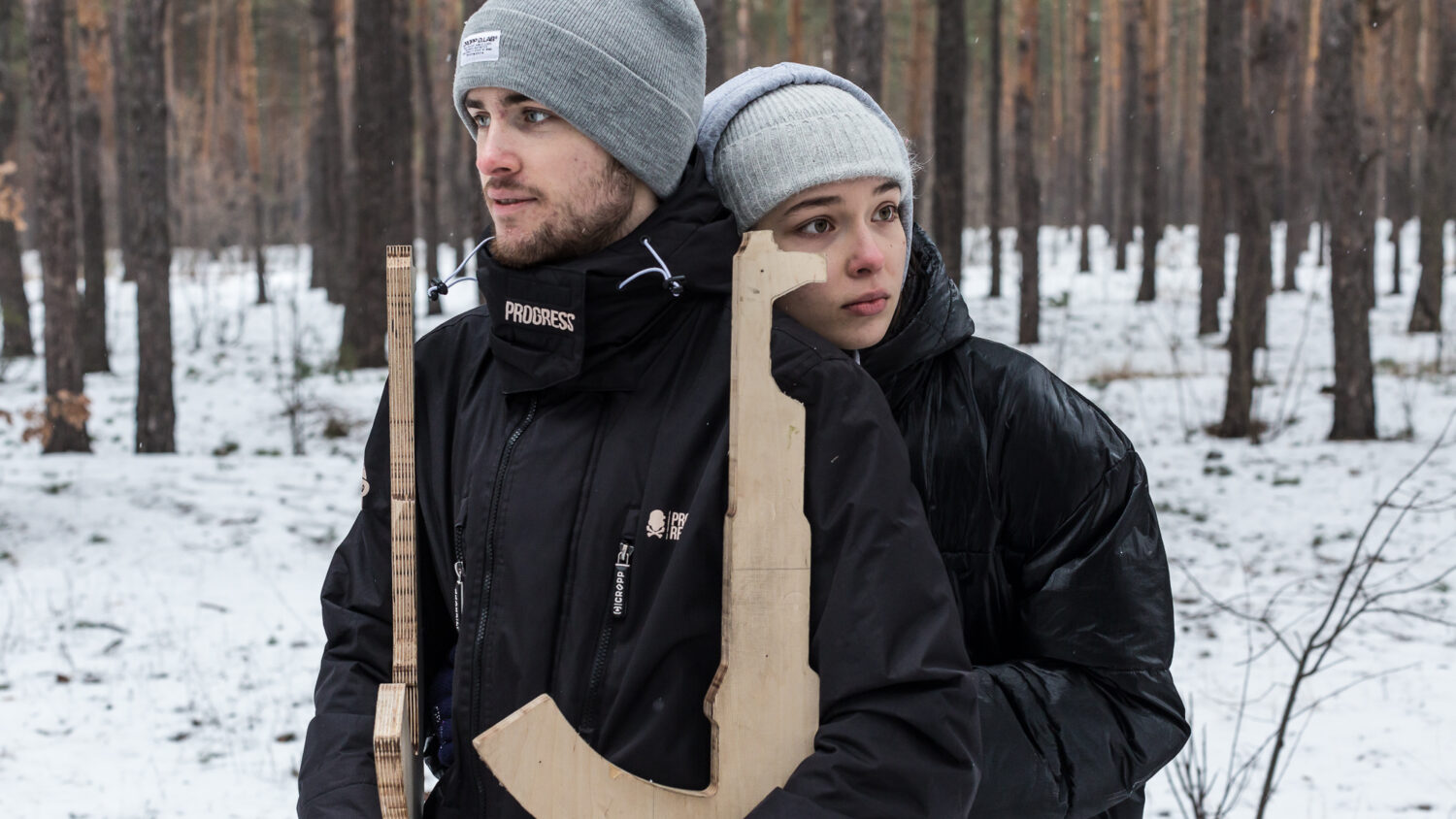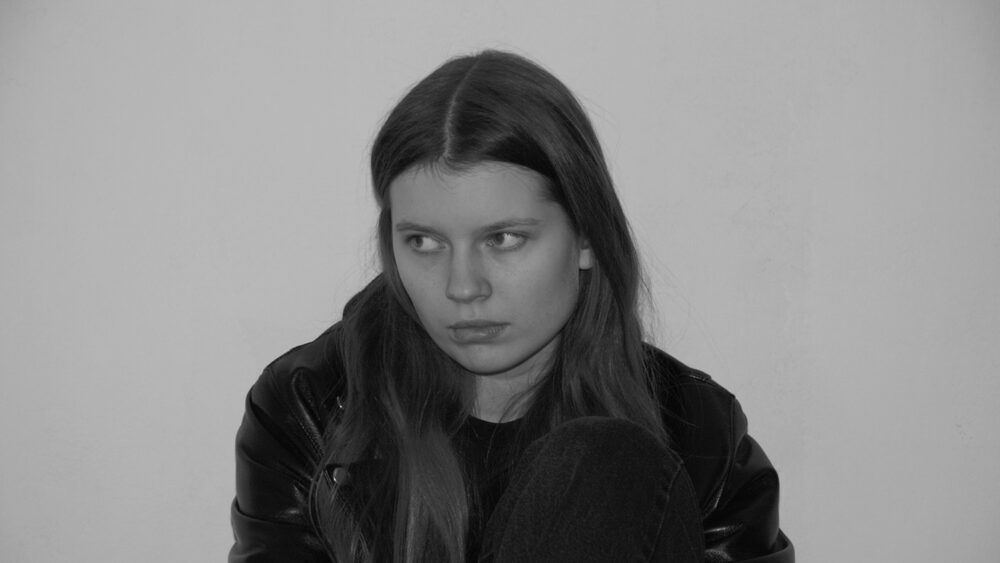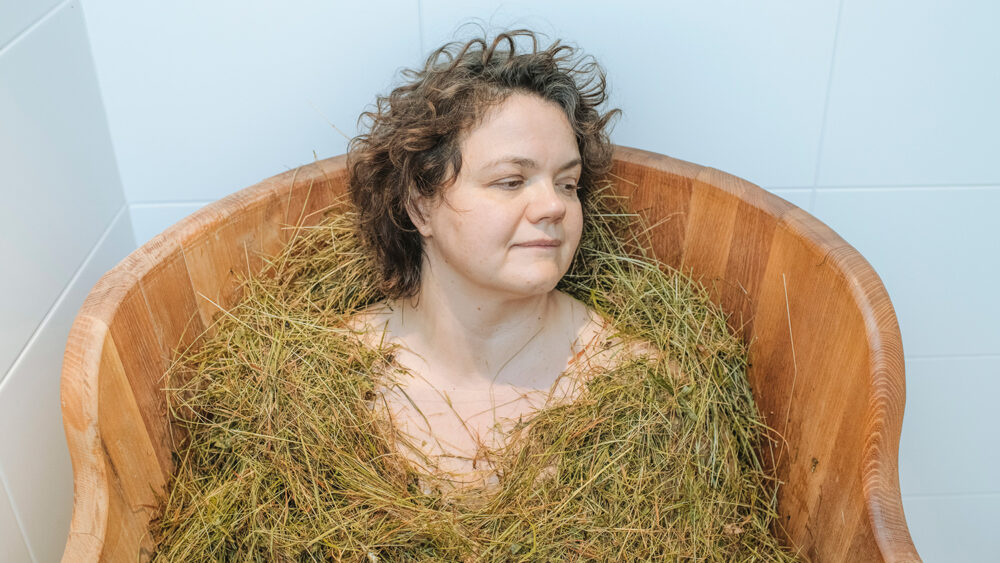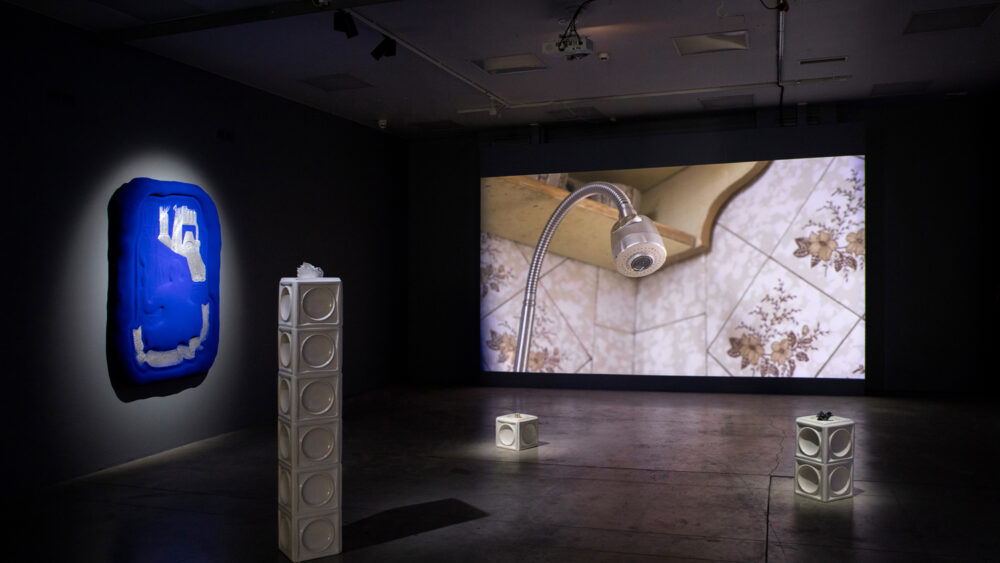A million stories to be told. Interview with Oksana Parafeniuk
Oksana Parafeniuk (1989) is a self-taught Ukrainian photographer who is interested in exploring creative approaches in documentary photography. She has been one of the top photographers covering Ukraine, working for biggest newspapers and magazines worldwide such as The Washington Post, The New York Times, and Le Monde, all along searching to express her views in personal projects.
When we talk, she is temporarily based in Barcelona, rocking her eight-month-old son to sleep. She admits that she constantly lives with guilt – for not being in her country, for not contributing through what she does and questioning what kind of life she can offer to her son, if in Kyiv, for instance, she had to run to hide in the underground, carrying her infant in her arms. A nightmare come true.

How did you get interested in photography and why specifically in social documentary photography?
I think it was in 2008. A friend had a camera, I tried to take a few photos and I thought, it would be nice to have my own camera. It took me about half a year to save enough money from my salary to buy my own simple DSLR. For many years I was just photographing landscapes, friends, portraits — it was a hobby. But at the same time, I was looking at a lot of photography online, attended exhibitions and my uncle, who I think also influenced me, had a lot of photo books by various famous photographers. I became curious. He used to live in Kharkiv and now, because of the war, he lives in Lviv. He would bring me photo books on the train, one or two, and then he would bring them back. That’s how I got access to the photo world. Back in those days, you couldn’t find a selection of photo books, so it was definitely helpful to have him showing me work. Actually, the very first photo I ever took was when I was around 10-11 years old. I took the image of my mother, my uncle and my grandmother (their mother) on the old wooden bench near my grandmother’s house with my uncle’s Nikon film camera. The image had a tilted horizon which is still my problem [laughing out loud].
In 2014, I quit my office job and started working as a fixer and producer for foreign photographers. There was a lot of interest in Ukraine – the Maidan revolution and eventually the war in eastern Ukraine. I never thought that I wanted to be a journalist. I actually didn’t even know how it worked. But through working together with some really good international correspondents, I learned journalism in the field. After a few years, in 2016, I strongly felt I had to transition to be doing my own work and that photography is what I’m the most passionate about. My first assignment was in 2017 for an American publication (U.S. News & World Report). I am forever grateful to their photo editor Avijit Gupta who trusted me to do the assignment without having any significant publications. He looked at my “Goalball: Field of Vision” project and decided it’s good and hired me, and it went pretty well. After that I slowly started getting more assignments.
And why documentary? Because I was deeply fascinated by humanity in general, by different facets of people’s lives, by their resilience and dignity, and documentary photography seemed like the most organic tool for me to both satisfy my own curiosity about the country I live in and about how people live through difficult events, including the war in eastern Ukraine that started in 2014. Also, I was interested in spreading these stories to larger audiences and hopefully get people more involved. My mom told me that when I was just a few years old, she would come to the playground, look at kids, and everybody was playing, but I was standing in the middle of the playground very serious just observing others play. That is exactly how I feel when photographing people, trying to be a sensitive and attentive observer to preserve at least a little bit of those human moments.

Would you say that your interest in photography is related to the political situation in your country?
Yes, I think so. Sometimes I think if all of the events hadn’t happened, I don’t know if I would have gotten interested in documentary photography. Seeing this brutal annexation and offensive by Russia taking place in my own country, I felt like it was important to do the work. I’ve never really worked abroad because at the end of the day, I feel like I don’t have profound knowledge on other countries, I don’t know much about people there, or the language. So I wondered, am I really the best person to tell their stories? Thus I ended up mostly working in Ukraine. At the same time, I am still curious to try to work abroad just to understand the context in which foreign media work in other countries, to see how challenging it is to be on the other side. I learned French and hopefully will learn Spanish to be able to speak the same language with more people in the world. Now, with the full-scale invasion by Russia and all the horrible things that are happening, I think we will have to tell stories about my home country Ukraine for so many years, decades, or, it could be work forever. There are stories to be told from places hard to reach, from occupied places that nobody can access right now, about people who are not ready to share what they have lived through yet. And the war is still ongoing. There are so many things, so many stories happening, each Ukrainian is affected in one way or another.
What are your future plans? Do you intend to go back to Ukraine and continue photographing the war? You had a baby, did it influence your future plans?
This is a big question that I am trying to figure out. Being pregnant during the invasion has been very complicated. I gave birth in Poland, not to go to the basement during an air raid siren or to be sure to be able to provide if the baby needed immediate care, but of course, a lot of women keep giving birth and raising children in Ukraine which is so much harder on many levels. We came back to our home in Kyiv in August. When my son was three months old, I did a few assignments. There were a lot of air raid sirens. It was really stressful, but when you have a baby it’s the next level stress. A month later, in October, Russia started shelling all of Ukraine, including Kyiv, with missiles, with the main goal to destroy the energy infrastructure, but also civilian areas. Some rockets hit the downtown Kyiv and we could hear them well from our apartment. We had to go down to the subway to hide, and those attacks started happening every week or so. Often there was no electricity — all the breast milk I had frozen for when I’m not there got spoiled. That’s when I understood that I can’t imagine leaving him anymore with anybody. I cancelled all my work. And since the day I stopped working I have been thinking about the work every day and how I really wish I could be working. It is difficult. When you worry about your own safety, about your family and friends, it’s really hard to just be a journalist and to tell stories. You need a little bit of distance and to focus on other people’s lives. We have been moving a lot, but our ideal plan, depending on the situation, is to go back to Ukraine, maybe in a few months, and I can try to go back to work and we will do shifts with my husband to stay with our son.
Do you feel guilty?
I definitely do. It’s a guilt on different levels, for not being in my country, for not being close to my family, for not working, not contributing enough to the information being spread about Ukraine in the world. But when we were in Ukraine, I also felt incredibly guilty for putting my son at risk, for when he had to play in semi-darkness during blackouts, for making us hide in the cold subway during the air raid sirens, for being constantly stressed. I think guilt is and will be present no matter what. That is probably why we go back and forth to Ukraine.

How dangerous was it to take photographs in the war?
When the invasion started, I was almost 6 months pregnant. I basically stopped working in early April because most of the assignments had a lot of risks. I had been working for a few months right before the invasion often photographing territorial defence trainings, went to the border between Ukraine and Russia, went on the coast guard boat in the Black Sea just a week before Russia started its massive offensive. Last time I went to the frontline, which at that point, was a bit more predictable, was in December while being 4 months pregnant. I was still at risk, obviously. I can’t say that I wouldn’t go at all to the front line, but it would depend on each particular situation, assessing the risks. And assessing the impact of the picture on the audience. Maybe it is more important to go somewhere for a longer time and focus on human stories. This is in many cases an artillery war. It’s really hard to photograph and to tell about it in a way that would be impactful, plus many other very brave and dedicated photographers are doing that kind of work. But the first month after the Russian full-scale invasion I was still working, and we were mostly in Vinnytsia and Lviv, which were considered safer, but that is where I saw rockets flying in the sky, and heard other explosions in Lviv.
What do you want to tell with your stories?
If you’re working on an assignment, you would end up photographing whatever you are asked to, but my main interest is the civilian population. They are often quiet stories in the sense that nobody talks about them because they’re not overwhelming, but there’s a lot of people and a lot of struggle in probably every village on the front line. There’s probably someone in a wheelchair who can’t even get to the basement during shelling. There are women with kids, women giving birth, but they didn’t leave the frontline for one reason or another. There are people without access to medication. And this list of absolutely crucial human stories can go on and on. All these stories are really important because they show the human toll of what’s happening and I think audiences can really relate to these kind of stories. This is what I would like to do – tell those kind of stories. I would of course want to go to the places that were occupied and now are liberated by Ukraine. There are a lot of stories about what happened there. People might be reluctant to talk about some of it for a while that is why it’s important to do it for years to come.

How is your time divided between assignments and personal projects?
The requests right before the full-scale invasion got so intense, I had assignments almost every day but it’s been a while since I have done personal work. But hopefully it can resume soon.
Do you know what your next project will be?
No, I have been thinking a lot, but I haven’t really made the decision yet. It is hard to decide on a project while you’re away, just sitting and reading news instead of being in the field and meeting people directly. In a way, right now, there are a million stories that need to be told. I think I need to come up with a different visual way to tell a story because documentary photography is good for certain things, but for certain ideas you need to have other visual, creative approaches. The last personal project I did was about COVID – Dreams in the Time of Coronavirus. It was about dreams or nightmares that people had during the pandemic. In December 2021, when I was in a hotel in Donbas pregnant after just working at the front line and reading all the predicaments about the Russian full-scale invasion, I felt a lot of anxiety and I had a dream that I was running with a newborn baby under shelling and trying to hide. When I think about the dream, I still remember how I felt. Interestingly enough, some time later, there was shelling in Kyiv and I was going with my little few-months-old son to the subway, so it almost became true. I think that a lot of Ukrainians have vivid dreams, terrific or maybe soothing, or that refugees outside of Ukraine might have dreams of their homes. Maybe I will do another chapter with the project because dreams are just fascinating. I see crazy dreams every night, but I haven’t come up yet with any precise visual idea on how to execute it.
Has the experience of motherhood changed the way how you look at things? Politics? Photography?
Yes, I was also just thinking that taking this time off and having a son is probably going to change the way I look at things and what kind of stories get me interested. I think your understanding, sensitivity and perception of the humanity just goes on some other level. With regards especially to people who have children, you just understand what people are going through on a much more profound level. Having children is such a universal experience, but until you have your own you only understand it partially. I hope that having a child myself will help me become more sensitive and attentive, observe and notice different kinds of intimate moments, understand why people make certain decisions in difficult times, and how to tell it to the audience.
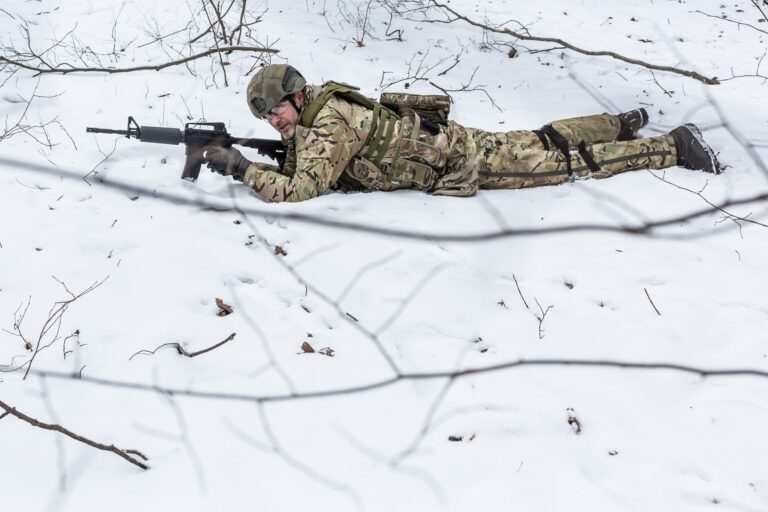
Where were you on February 24th last year, how do you remember this day?
I was in Kyiv, at home. On February 23rd I had an assignment for a Danish newspaper. I was just very tired because I was pregnant and I was working absolutely every day, and like really long days, for like two months. The mood was that it was going to happen but that night some other colleagues told us that it seemed like Russia would actually do it the next day. I remember that in the evening of February 23rd, I went to the bedroom where my sister was sleeping, and I taped her windows to protect them in case of the shelling. I was crying while doing it. And then we tried on some body armour that wouldn’t really help you if there was a big shelling, and then we went to sleep but I couldn’t sleep all night. I was reading news and then, around five in the morning, I heard an explosion, it wasn’t loud, but I just knew what it was. I woke up my husband and my sister and I said that it had started but couldn’t believe that it was actually happening. We sat on the floor, drank coffee and my husband went to work and me and my sister, we went to a hotel to work with NBC. I didn’t go to take any photos, I just couldn’t. The events blocked my ability to think about photographing, and then we left the next day to Vinnytsia, a city a few hundred kilometres west from Kyiv. A trip that usually takes 3 hours took us 12.
Is there anything you can do through photography that helps you, and maybe others, to live with or transform the trauma?
That’s a good question. I think there could be something. On certain days I can’t photograph but on other days when I actually try to pick up the camera and look at the world through the viewfinder and observe different moments, I feel it just helps me to step outside of my life, analyse and see. It also helps to appreciate little moments, intimate moments. I know a few photographers who did workshops with teenagers who had been through some difficult experiences. With the help of photography, they could get over the trauma. I’m not trained for this, but I think this is definitely an interesting and important topic, to talk about trauma. I would be interested to explore and learn how to use photography to talk about it. Any time that I’m working with someone who has lived through traumatic experience, I’m trying to be careful because you shouldn’t traumatize people even more. Photography, if not to help to treat trauma, could definitely raise awareness that you’re not the only one living through it, that you’re part of a community and it just helps you not to feel alone in your own trauma. Then the question is where do we need to show these photography projects exploring trauma for the right audience to see and access it?
Photographer Kevin McElvaney did a project where he, instead of photographing himself, gave cameras to refugees from Syria. And they photographed their own life for a month and wrote something about it. When we talk about trauma, it’s possible that you wouldn’t be able to really tell the story in an impactful way if you haven’t lived it. My very first project was about the displaced, entitled “Wooden Box of Photographs”. It is a collage about a displaced family from eastern Ukraine in 2014. The most interesting part about it wasn’t even the collage but that we spent time together and we talked about our memories, about places important for us. It helped them to feel more at home, we felt a little bit more connected. It’s interesting that now I’m displaced by the war, maybe I will continue this project in some way. When storytellers are working with people with trauma, we need to ask them what they think the story should be instead of imposing our own preconceptions about it.
At some point, it felt too overwhelming and I really wasn’t doing very great emotionally. I talked to a psychotherapist for the first time in my life, and he told me that in Ukraine the number of people who take antidepressants has increased from 14% to 30% or something like that. Ukrainian society is traumatized and that’s something that will not just go away very fast. The first week after the invasion I was working for Der Spiegel. We went to a meeting where the psychologists meet and talk among themselves, that was a certain therapy for them. And it was very emotional to be there and see them. Everybody is impacted, some people to a bigger extent, of course. I consider ourselves lucky, our apartment is still there (for now) and so far, nobody from our family has died or got injured even though a few members are in the military. A lot of people have lived through much worse.
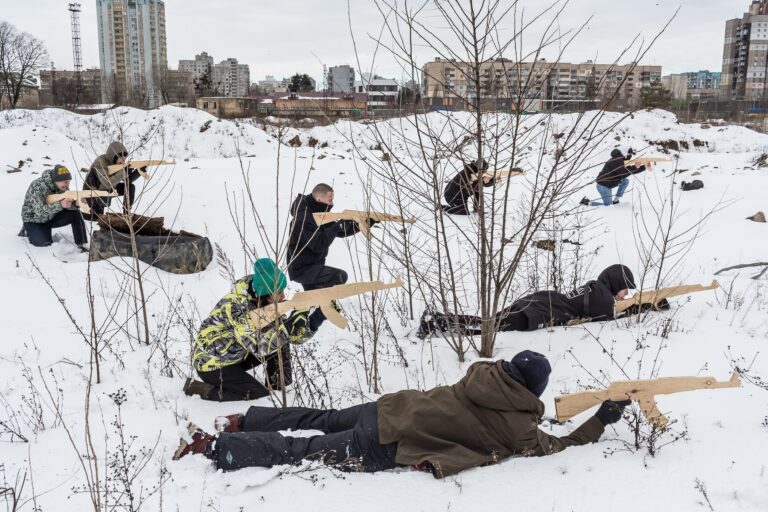
Are you involved in any projects with a goal to help Ukrainian army or people?
Most of my efforts are focused on sharing visual work about Ukraine. It’s not comparable with the work of many other Ukrainians, especially those who fight and volunteer. It mostly happens thanks to Kateryna Radchenko, a curator and the founder of the international photo festival Odesa Photo Days, who since the invasion has organized so many exhibitions all over Europe showcasing the work of Ukrainian photographers. She’s also judging the World Press Photo contest this year. She has just published this newspaper “The Information Front” that has some of my work in it too, spreading information through photography, and all the profits are donated. Also, part of the income from all the exhibitions is donated to one of the charity projects.
How masculine the documentary photo and photo journalism world still is? How do you feel in this context?
I think it’s still not really equal. When I was in Ukraine, at certain events or press conferences the majority of photographers were men. The industry is not always the friendliest but I think it’s slowly changing for the better thanks to certain people in the industry who are motivated to improve it, thanks to initiatives like Women Photograph or The Journal, and thanks to women who showed that it was possible to do this job as a woman, but there’s still a lot to change. Some photo editors that I work with are really trying to make sure that they hire a lot of women as well. Last week, I was in Marseille. There is a photo exhibition of Ukrainian photographers, including my work, at Le Centre Photographique Marseille. The Centre’s director said that they couldn’t do any photo exhibition if they didn’t exhibit women too. So I joked that hopefully I was invited because of my work.
It’s like meeting the quota.
It’s good to have the quotas but it’s just touching the surface because having enough opportunities for women (*trans, non-binary people, people of colour, there are many inequalities in the industry) is not everything. There are so many deeper issues to address, starting from how we are raised in family and society, how we learn about gender equality and what it actually means, how to improve postcolonial remnants, how society is established to help with child care, what role models we see growing up, and many other things. There might not be enough women* that had the opportunity, support, and access to reach the level of professionalism to submit their projects. The problem is not about quotas, the problem is making sure that talented women* can actually do the work.
It took me many years to even believe that I could work as a photojournalist, I’m not even talking about war journalism. I didn’t know where to start and the attitude from colleagues was not always supportive. If the editors of big publications hire mostly men, and mostly white men then, of course, this is the work that will be submitted to contests, but just because women* didn’t have a chance to do the work doesn’t mean they couldn’t.
